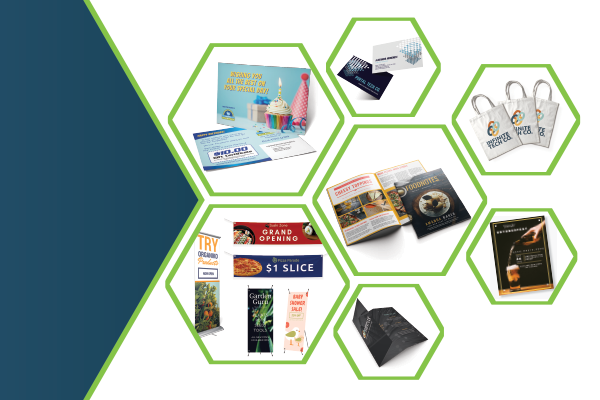
Introduction
In today’s competitive business landscape, effective marketing is crucial for capturing the attention of potential customers. While digital marketing has become increasingly popular, traditional marketing materials such as brochures, flyers, and business cards still hold value. To make a lasting impression, businesses are turning to innovative printing techniques to enhance the visual appeal and quality of their marketing materials. This article explores the top 10 trending printing techniques that can elevate your marketing efforts and leave a lasting impression on your target audience.
1. Metallic Foil Printing
People enjoy things that are shiny. They pique our interest. So why not make use of that in print design trends?
Designers may use foil stamping to add a little glitter to their print products, adding a touch of luxury to their marketing materials. This standout print marketing approach is ideal for emphasizing significant components like logos, text, or images, making them stand out with an attractive and polished appearance.
Foil stamping, like die cutting, employs a pre-made die to glue a mylar-backed foil (rather than ink) to a printed sheet or colored paper. A foil stamping dies, on the other hand, is heated. When the die is heated, the foil adheres to the die’s pattern when it is transferred or imprinted onto the printing substrate.
That is why it is called stamping. The metallic finish gives your items a feeling of high quality and exclusivity, making a lasting impact on your target audience. Metallic foil printing, whether on business cards, brochures, or invitations, can take your marketing materials to the next level and make them genuinely memorable.
2. Embossing and Debossing
Embossing and debossing are techniques that create raised or recessed designs on paper. These Product label printing techniques add a tactile dimension to your marketing materials, making them visually appealing and memorable. Embossing raises certain elements of the design, while debossing creates depression. By using embossing or debossing, you can add texture and depth to your business cards, brochures, or packaging.
3. Die-Cutting
Die cutting is the process of transforming flat printed sheets into the shape and structure of a finished printed product. A die-cutting machine removes any extra from the sheet, leaving just the real product you wanted to manufacture. Consider it a cookie cutter for paper or other print substrates. You may create a visual experience using these unique printing techniques that catches attention and generates interest by combining die-cutting into your marketing materials.
4. Spot UV Coating
Spot UV coating is a printing technique that involves applying glossy varnish to specific areas of the design. This creates a contrast between matte and glossy surfaces, making certain elements pop. Advanced printing methods include Spot UV coating that can be used to highlight logos, images, or text, giving your marketing materials a sophisticated and professional look. This technique works especially well on business cards and brochures, adding a layer of elegance and refinement.
5. Thermochromic Printing
Thermochromic printing is an intriguing technology that produces color-changing effects by using heat-sensitive inks. When exposed to heat or cold, your marketing materials might alter and disclose concealed messages or pictures. Thermochromic printing adds a layer of surprise and engagement to your print, captivating your audience and making a lasting impact.
6. Letterpress Printing
Letterpress printing is a traditional technique that has made a comeback in recent years due to its vintage and artistic appeal. It involves using a raised plate to press ink onto paper, resulting in a textured and tactile effect. Letterpress printing adds a unique and artisanal quality to your marketing materials, making them stand out in the digital world.
7. 3D Printing
3D printing enables the creation of three-dimensional objects and textures that can be seamlessly integrated into marketing materials. From dimensional logos that pop off the page to lifelike product replicas that allow customers to visualize their purchases, 3D printing adds a new level of visual impact and innovation to your marketing efforts. By leveraging 3D printing, you can captivate your audience and create a memorable brand experience that sets you apart from the competition. Whether it’s creating interactive displays, unique promotional items, or engaging event installations, 3D printing empowers you to showcase your brand in a visually striking and attention-grabbing way.
8. Augmented Reality (AR) Printing
Augmented reality (AR) printing, which combines the physical and digital worlds, elevates traditional printed materials to a whole new level. Customers may scan printed photographs and watch dynamic digital information come to life by utilizing an AR app. AR printing delivers an immersive and engaging experience, allowing you to transmit complicated ideas to your target audience while captivating them.
9. Glow-in-the-Dark Printing
Glow-in-the-dark printing makes use of special inks that absorb and emit light to provide a bright effect in the dark. By including glow-in-the-dark features in your marketing materials, you may capture attention and leave a lasting impact, especially in low-light situations. This method is effective for event marketing, nightclub advertising, and children’s items.
10. Variable Data Printing
Variable data printing allows you to personalize your marketing materials by incorporating individualized content such as names, addresses, or unique QR codes. This technique enables you to tailor your materials to specific recipients, enhancing the relevance and effectiveness of your marketing campaigns. Variable data printing can be utilized for direct mailers, personalized brochures, or event invitations.
Conclusion
Innovative printing processes may dramatically improve the aesthetic appeal and impact of your marketing materials. These approaches, ranging from color label printing, and metallic foil printing to augmented reality, provide unique ways to catch attention, engage your audience, and leave a lasting impact. These 10 print strategies are just a few examples of how you may impress your consumers and increase response rates. Despite the fact that print has one of the greatest response rates, don’t settle for ordinary by sending the same materials as everyone else. Instead, get creative and stand out by utilizing all of the print methods and technology at your disposal.
